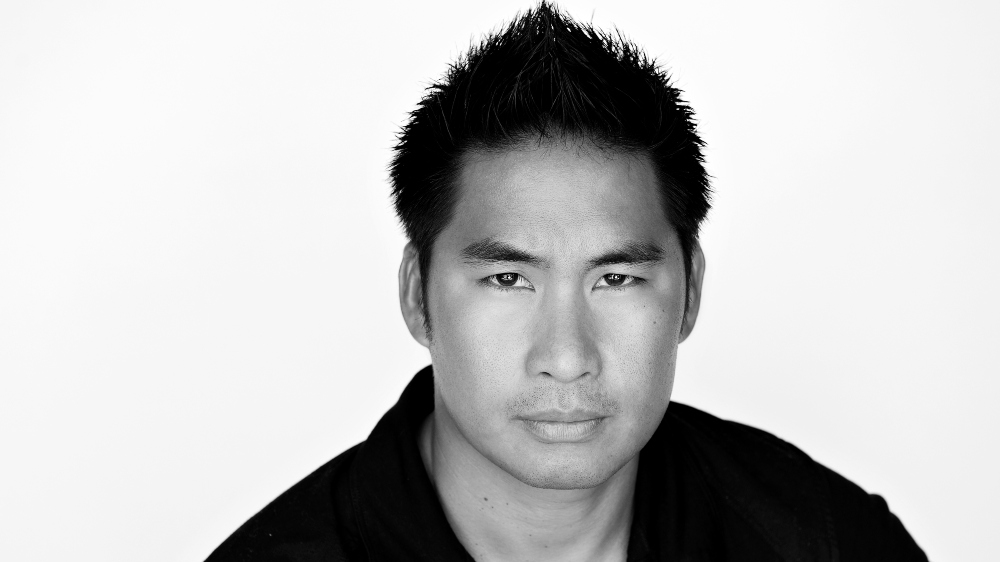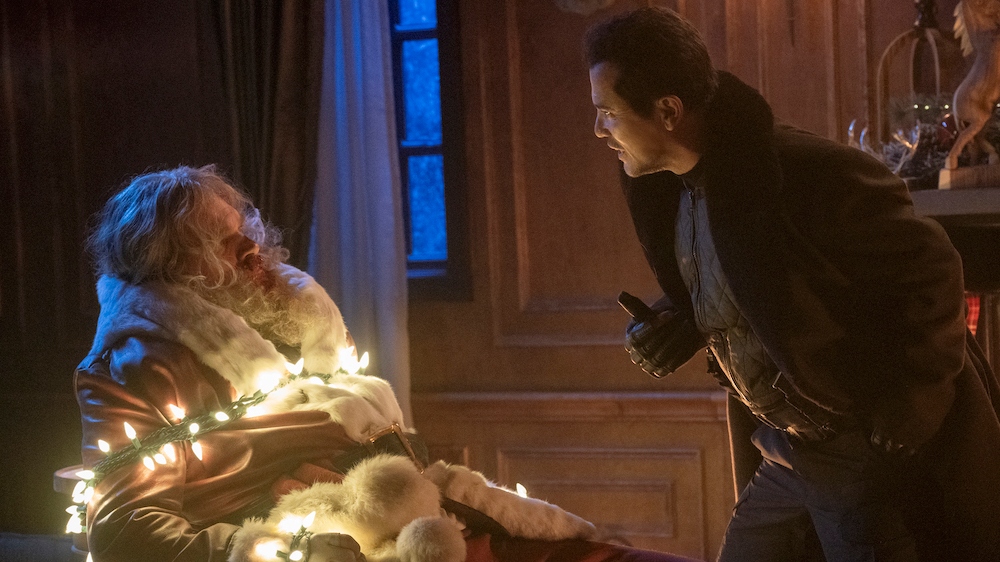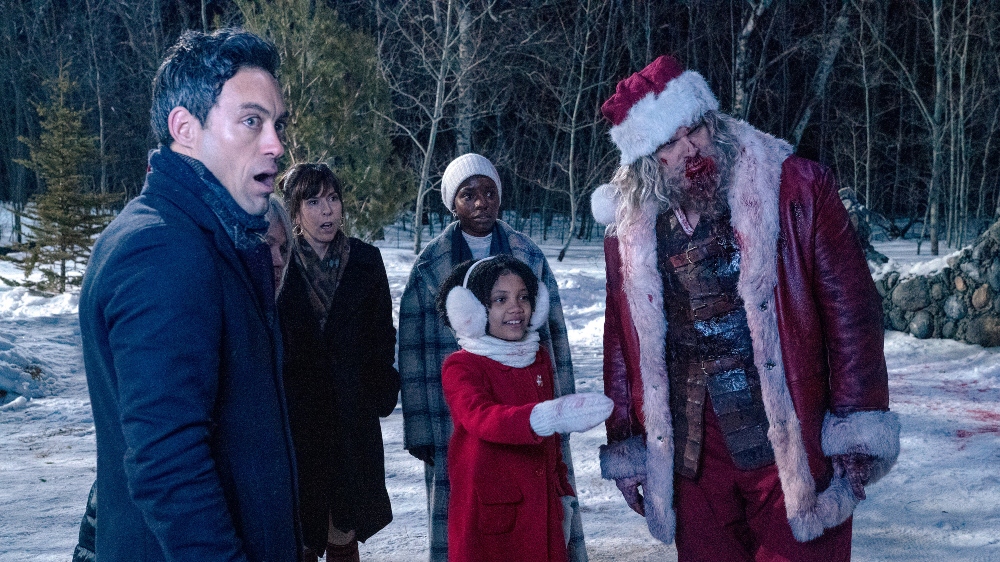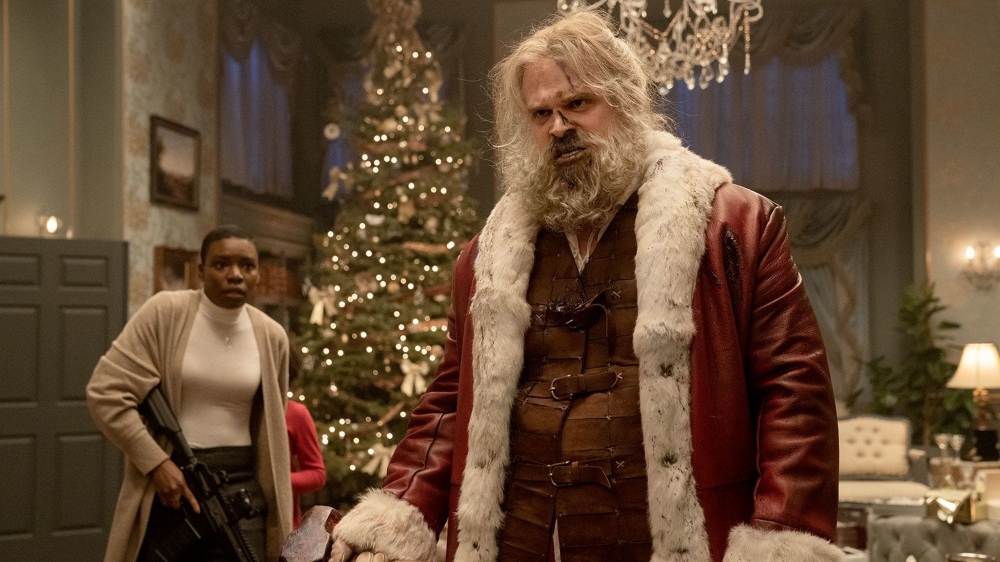What’s Santa Claus doing sitting in a dingy bar? “The whole planet runs on greed,” he complains to patrons before downing another shot and lamenting the long, reindeer-led journey ahead. Later that evening, he will encounter a family held hostage by Christmas-hating crooks. Before the night is over, Santa will prove once and for all whether the stories about him are true.
Directed by Tommy Wirkola (Netflix’s The Trip, the Dead Snow franchise), Violent Night stars David Harbour (Stranger Things) as Santa Claus, who is determined to deliver Season’s Beatings to those who cross him, including John Leguizamo.
The action movie is the latest project from 87North, a production company founded by David Leitch and Kelly McCormick. Few filmmakers can compete with Leitch and his 87Eleven collaborator Chad Stahelski when it comes to pure action — just look at John Wick, Atomic Blonde, and Nobody, all of which brought something fresh to the genre.
Leitch and McCormick teamed with Guy Danella to produce Violent Night, and Leitch turned to his longtime collaborator Jonathan “Jojo” Eusebio to serve as the film’s stunt coordinator and second unit director. Eusebio has worked on an incredible array of films marked by superior action, from entries in the John Wick, Matrix, and Bourne franchises to Marvel movies like Blade II and Deadpool 2.
Eusebio recently spoke with Below the Line from Australia, where he is currently working on Leitch’s next film, The Fall Guy, which stars Ryan Gosling and Emily Blunt. He talked about how he watched Black Widow as part of his preparation to train Harbour, and why working with kids isn’t too different than working with adult actors (safety remains the top priority).

Below the Line: How would you describe your relationship with David Leitch and his 87North partner Kelly McCormick?
Jonathan Eusebio: I knew Dave before I got into stunts. I grew up in the same kind of martial arts school. Kelly [McCormick] was my first agent. So I’ve had a good relationship with them from early on. It was great to see them rise up through the ranks. They never really changed their attitude. Their mindset is always on how to deliver action on a big scale.
BTL: Can you define 87North’s approach to action?
Eusebio: For us, action is always character-driven, no matter what. You can’t just do action for action’s sake. It has to complement the character. When we design action, we are always thinking of how much our cast can do. We want them to do the majority of the action themselves. So we try to keep the stunts true to the characters and true to the actors’ abilities.
BTL: One thing I love about your action scenes is how they show the physics of the stunts. If someone slams into a wall, they realistically show how someone would react and what would happen next.
Eusebio: It’s just like anything else — you have to base action on what’s real. The foundation has to be real. The structure has to come from something real. So a lot of the stuff we do is based on what would happen in real life. The cause and effect of action. We might cinematize it for the movies [and] make it a little bit more grandiose for the camera. But when I do choreography, I try to base everything [on] something real. When I say “real,” I mean real technique, real body mechanics, those kinds of things. That’s why I like to train the cast before their fight scenes. That way, I know how their body mechanics will behave.
BTL: How involved were you with training David Harbour and John Leguizamo for this film?
Eusebio: Part of our job when we design the sequences is to train the actors to do them. Personally, I like to get them early on so I can teach them a base library of movements. I learn how they move, so if on the day we have to change something, we’ve built a certain level of trust and I know that they will be able to do it.

BTL: Harbour’s done action scenes before, notably in Black Widow.
Eusebio: Right, so when I watched Black Widow, I could see his level of coordination. I was very confident that he’d pick things up pretty quickly. Black Widow only had a few fighting scenes with him, but for this [film], he really took the bull by the horns and just kind of went for it.
BTL: There’s an early fight where he tries to vault over a pool table and he just can’t make it, so you’re actually tailoring the action for him, right?
Eusebio: [laughs] When we design stuff sometimes, those things will happen during rehearsals. Those little nuances are important when it comes time to choreograph a scene. It could be [that] you’re constricted by your costume, or you’re just tired sometimes. Y’know what I mean? You’re not flexible.
We try to find those nuances [and] limitations and use them. What would bother David’s Santa? Build that in. We played around [with] a bunch of different versions of that fall. The way he played it was pretty funny.
BTL: Did you change your approach when working with Leah Brady, who plays young Trudy?
Eusebio: I was a little more lenient with her. With child actors in general, you have to do a slow progression. And you have to be very safe. I don’t change the progression per se, I’m just more mindful that they’re younger and more fragile. I always raise the action to the level of what their athletic ability and concentration are. So you have to take in the fact that they’re children, but the progression’s the same — you start really small and build up, build up, build up.
BTL: Your approach to fight scenes reminds me of classic Hong Kong films.
Eusebio: We all grew up watching those movies. I love old-school Hong Kong [movies starring] Donnie Yen, Jackie Chan, Sammo Hung, [and] Yuen Biao, [and] the Hong Kong industry from the late ’70s to the mid-’90s. I have an Eastern sensibility when it comes to action, but I think I have a Western sensibility when it comes to story.

BTL: Hong Kong action films have a distinctive rhythm, much like your action in Violent Night. Going into the film, did you know the music that would play over the action scenes?
Eusebio: No, they were Tommy’s choices. I love the songs he picked, his choices were amazing. But when we are prepping, I’m not choreographing to any particular music. For me, the rhythm comes from the movement. Sometimes ambient sounds help. Like, on John Wick, we used a certain rhythm for the gunfire.
There is a rhythm to our fights, but not necessarily one that’s tied to beats of music. Like I said, I grew up on Hong Kong films, so that’s the rhythm I know. When I’m training at kickboxing or boxing, there is a rhythm on the pads too.
BTL: Does having an R-rating affect how you approach stunts?
Eusebio: We knew it was rated ‘R’ to begin with. I mean, just look at the title of the movie. So we [could] kind of work with no limits. The R-rating actually frees us a bit [and] makes it more fun.
BTL: What I loved about the fights in this film is how they keep escalating. You start with small encounters and props and build to these bigger, broader bits, like that spectacular sequence in the barn.
Eusebio: Tommy wanted to have a scene where Santa realizes, for the first time, who he really is. He wanted Santa to go crazy. This gave us the opportunity to go full throttle. We let David use all the stuff he learned. The barn was really the most fun for us. The tricky part was we had a very short time to shoot it. And the room we shot in was small, so we had to reconfigure a lot of things to make it appear bigger.
We had to shoot like a splinter unit, in between shots on the main unit. We would have to whisper while we were prepping, and then as soon as we got a window, we’d shoot pieces of the sequence. Overall, I think it’s really good. It’s my favorite sequence. It took almost a week to shoot, including a day or two for the main unit. But we prepped really well, so we knew our pieces going in.
BTL: Can you talk about working with the cinematography department?
Eusebio: The camera crews are just as instrumental in the fight as everyone else. They have to know the choreography just as well as the players because the fight only looks as good as what the camera sees, right?

BTL: I know you must have previs’d. Were you able to change any sequences on the set?
Eusebio: We had a very short period of time, so we previs’d a lot. Tommy would tell us what he wanted, and then we would give him options. He was very good with prepping, then we would stay with our plan and execute. We did have the liberty to make up things on the set, but it came from a skeleton that we already had designed.
BTL: Can you think of a time that happened?
Eusebio: Santa’s first fight with Tinsel [Phong Giang] we had prepped in a more conventional way — coverage here, coverage over there. But then Tommy decided to stage it as a oner — a single, long take. We had to figure out how to execute this with David while still preserving a level of energy for the fight. Usually, that’s weeks and weeks of rehearsal, but we mapped it out the day before. It actually turned out really well.
BTL: The gorier scenes toward the end are shot with a darker palette, no?
Eusebio: That was a choice Tommy and [DP] Matt [Weston, FNF] made. Blood sometimes makes viewers queasy. And bright blood sometimes doesn’t look real. I feel that a lot of blood — gratuitous blood — tends to take people out of the movie.
BTL: Well, you don’t want actors actually dying, even though you are killing them on camera.
Eusebio: Right. Tommy is a master of those kinds of movies. He’s been influenced by Sam Raimi [and the] old Friday the 13th and Nightmare on Elm Street movies. But at the end of the day, we’re making a Christmas movie, right?
Violent Night is now playing in theaters nationwide courtesy of Universal Pictures.





